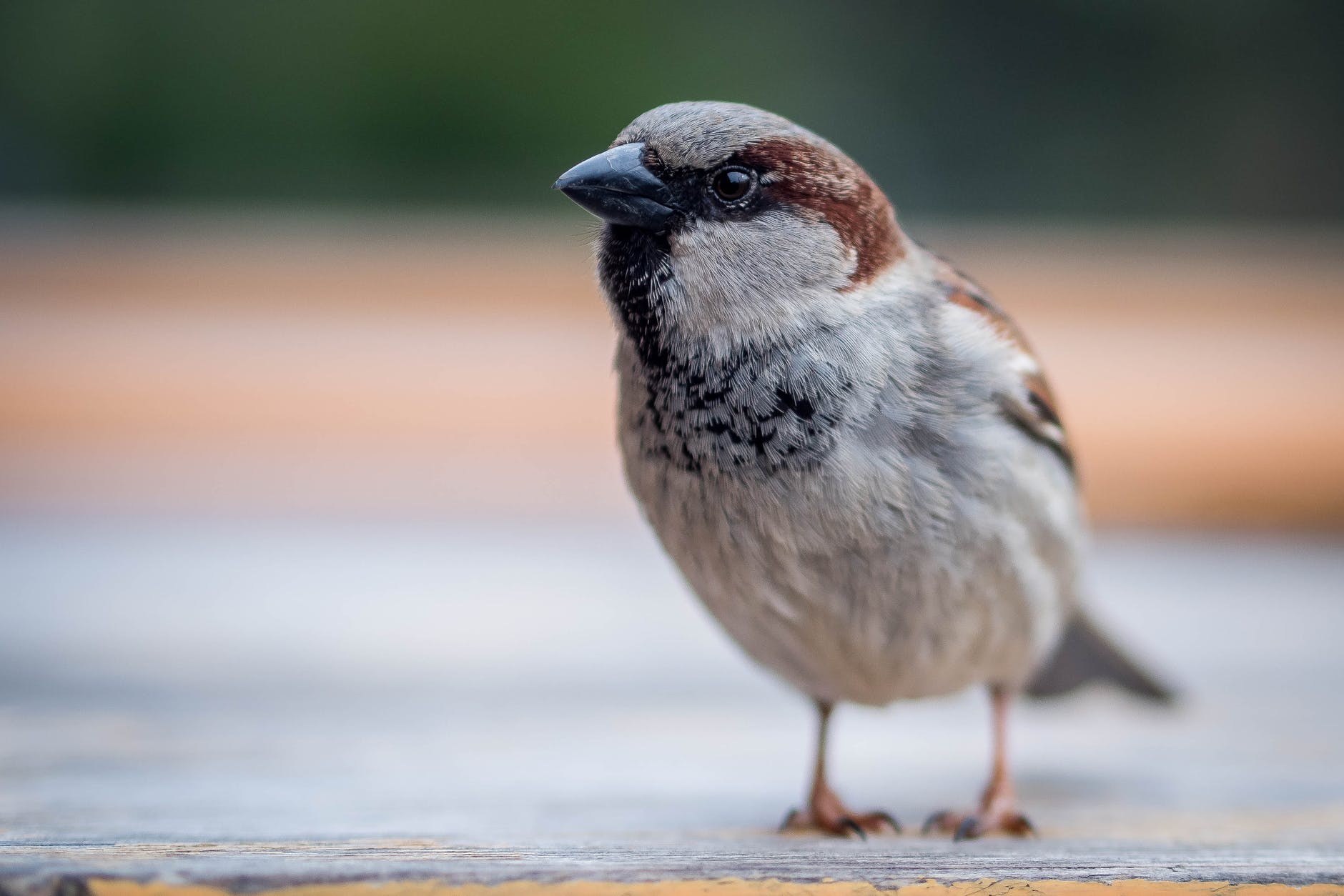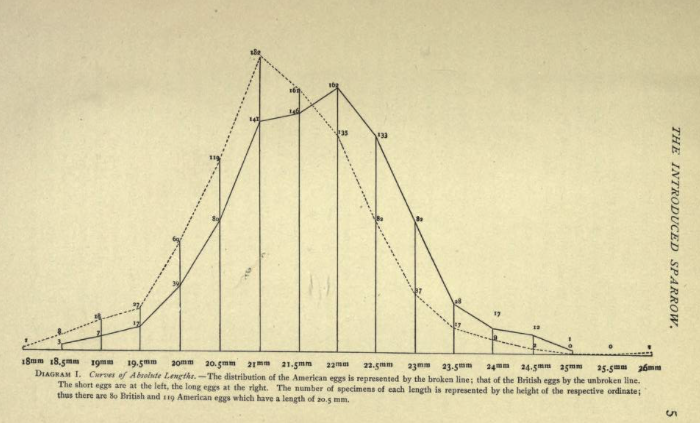Guest Post by Ted Anderson
Possibly the most influential ornithological paper published inNorth America in the 19th century was actually written by an invertebrate embryologist who was not even a member of the American Ornithologists’ Union. The paper “The elimination of the unfit as illustrated by the introduced sparrow, Passer domesticus” was written by Professor Hermon Carey Bumpus at Brown University in Providence, Rhode Island It was actually the second of two interesting papers that Bumpus published on the recently introduced house sparrow, but more on these below.

Bumpus was born in Maine in 1862, and entered Brown in 1879 to study biology, graduating in 1884. In 1886, he accepted a professorship at Olivet College in Michigan, a position he left in 1889 to complete a doctorate at the newly established Clark University, where he received the first PhD awarded by that university. In 1890 he returned to Brown as assistant professor of zoology and was promoted to professor of comparative anatomy two years later. He left Brown in 1900 to become assistant to Morris Jessup, president of the board of the American Museum of Natural History in New York City. A year later Jessup promoted him to become the museum’s first director.
In 1911 Bumpus moved into academic administration as business manager of the University of Wisconsin, a position he held until 1914. He then moved to Tufts College (now University) as President from 1915 to 1919. He resigned from Tufts to pursue his interest in building or remodeling homes including a Philippine bungalow on Long Island Sound (constructed of Philippine lumber from the Philippine Hall at the St. Louis Exposition), an Italian villa in a Boston suburb and the King Caesar House in Duxbury, Mass. Bumpus died in Pasadena, California in 1943.
 While teaching at Brown, Bumpus spent his summers conducting research on the development of marine invertebrates at the Marine Biological Laboratory at Woods Hole, Massachusetts, where he also served as assistant director from 1893 to 1895, and as director of the Biological Laboratory of the US Fish Commission. In 1896 he presented the inaugural lecture in a summer seminar series at the Marine Biological Laboratory entitled “The variations and mutations of the introduced sparrow, Passer domesticus”, which was published in 1898.
While teaching at Brown, Bumpus spent his summers conducting research on the development of marine invertebrates at the Marine Biological Laboratory at Woods Hole, Massachusetts, where he also served as assistant director from 1893 to 1895, and as director of the Biological Laboratory of the US Fish Commission. In 1896 he presented the inaugural lecture in a summer seminar series at the Marine Biological Laboratory entitled “The variations and mutations of the introduced sparrow, Passer domesticus”, which was published in 1898.
In that 1898 paper he was undoubtedly the first scientist to suggest that the introduction of house sparrows and their subsequent rapid spread across North America represented a huge experiment that could be used to study Darwinian natural selection. Taking advantage of that natural experiment, he compared the size, shape and coloration of 868 sparrow eggs from Massachusetts with an equal number of sparrow eggs from England, to test the hypothesis that the rapid population growth of sparrows in North America would result in relaxed selection. Without the benefit of statistical analysis—Francis Galton and Karl Pearson were just then developing some rudimentary statistical tests—he concluded from his graphs that eggs from Massachusetts were shorter and more variable in size and coloration than eggs from England. He also raised the question of whether the observed differences were phenotypic (‘ontogenetic’) or adaptive (‘phylogenetic’) and suggested that a common garden experiment would be needed to differentiate between these alternatives.

On 1 February 1898, a winter storm in Providence provided Bumpus with the material for another summer lecture at Woods Hole, which he then published. After the storm, 136 immobilized sparrows were brought to Bumpus’s anatomy lab, where 72 subsequently revived but the remaining 64 died. Bumpus identified the sex and measured nine morphological traits of each bird. Bumpus concluded from his graphs that males survived better than females and that shorter, lighter birds with longer legs, wings and sternums and larger brain size (“skull width”) also survived better. He concluded that his analyses showed:
Natural selection is most destructive of those birds which have departed most from the ideal type, and its activity raises the general standard of excellence by favoring those birds which approach the structural ideal.
…the birds which perished have certain average structural peculiarities which distinguish them from the survivors, and that the intensity of selective elimination has been felt most by birds of extreme structure [2]
In his 1899 publication, the entire dataset is reproduced in an appendix, thereby permitting many other evolutionary biologists, as well as innumerable students in evolution classes, to analyze Bumpus’s data statistically. Harris published the first statistical analysis, and at least ten other papers have been published since then, including papers by John Calhoun, Peter Grant , Richard F. Johnston and colleagues, and one by Russell Lande and Steven Arnold. Increasing complex and sophisticated statistical analyses were employed in these papers, and the conclusions of the various authors differ from those of Bumpus and from each other, in part due to the fact that many of the analyses use only subsets of the original data.
I do not know of another dataset of birds that has been subjected to so many analyses and so many different interpretations The history of reanalysis of Bumpus’s data is a nice example of a century of progress in both statistics and evolutionary biology
SOURCES
- Anderson TR (2006) Biology of the Ubiquitous House Sparrow, from Genes to Populations. Oxford: Oxford University Press
- Bumpus HC (1898) The variations and mutations of the introduced sparrow, Passer domesticus. Biological Lectures Delivered at the Marine Biological Laboratory of Woods Holl, 1896-1897, pp. 1-15.
- Bumpus HC (1899) The elimination of the unfit as illustrated by the introduced sparrow, Passer domesticus. Biological Lectures from the Marine Biological Laboratory of Woods Holl, Mass. 1898, pp 209-228.
- Calhoun JB (1947) The role of temperature and natural selection in relation to the variations in size of the English sparrow in the United States. American Naturalist 81:203-228.
- Grant PR (1972) Centripetal selection and the house sparrow. Systematic Zoology 21:23-30.
- Harris JA (1911) A neglected paper on natural selection in the English sparrow. American Naturalist 45:314-319.
- Johnston RF, Niles DM, Rohwer SA (1972) Hermon Bumpus and natural selection in the house sparrow Passer domesticus. Evolution 26:20-31.
- Lande R, Arnold SJ (1983) The measurement of selection on correlated characters. Evolution 37:1210-1226.
Footnotes
- graph: Bumpus 1898 page 5
- quotation: Bumpus 1899 pages 217 and 218
COMMENTS